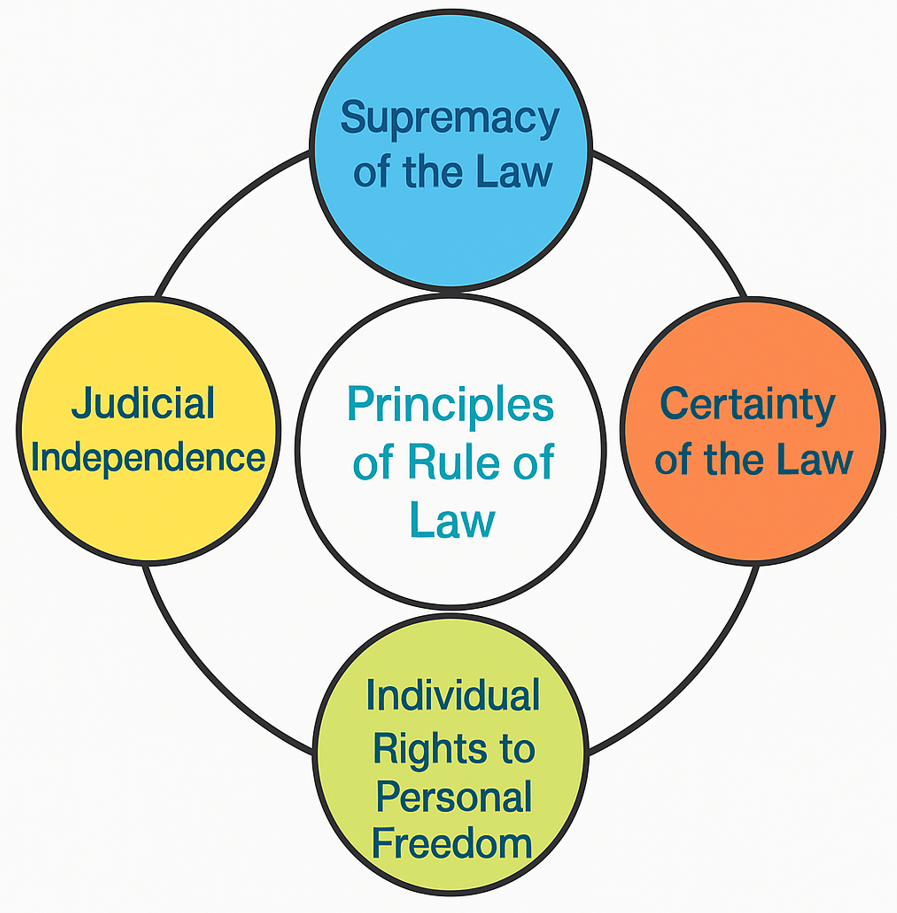There are no items in your cart
Add More
Add More
| Item Details | Price | ||
|---|---|---|---|
Mon Jun 30, 2025
పరిచయం:
భారతీయ శిక్షాస్మృతి (IPC) సెక్షన్ 124A (రాజద్రోహ చట్టం) యొక్క అనువర్తనం, శాంతియుత విభేదాలను అణచివేయడానికి ఉపయోగపడుతూ, "చట్టం ద్వారా పాలన" (Rule by Law)ను ప్రతిబింబిస్తుంది. దీని అర్థం న్యాయాధికారం లేకుండా చట్టపరమైన అధికారాన్ని ఉపయోగించడం. దీనికి విరుద్ధంగా, "న్యాయ పాలన" (Rule of Law), కేదార్ నాథ్ సింగ్ వర్సెస్ స్టేట్ ఆఫ్ బీహార్ (1962) కేసులో వ్యక్తీకరించినట్లుగా, అన్ని చట్టాలు న్యాయం, సమానత్వం, మరియు నీతి అనే రాజ్యాంగ విలువలకు అనుగుణంగా ఉండాలని నిర్దేశిస్తుంది.
విషయం:
I. ‘న్యాయ పాలన’ మరియు ‘చట్టం ద్వారా పాలన’ మధ్య భావనాత్మక వ్యత్యాసం
1. న్యాయ పాలన అనేది దేశం స్వయంగా చట్టం ద్వారా పరిపాలించబడుతుందనే సూత్రంపై ఆధారపడి ఉంటుంది. ఇది అస్పష్టత లేకుండా, చట్టపరమైన సమానత్వం మరియు విధానపరమైన న్యాయాన్ని నిర్ధారిస్తుంది.
a. చట్టం యొక్క ఆధిపత్యం, అస్పష్టతను తొలగిస్తుంది;
b. చట్టం ముందు సమానత్వం, ఏకరీతి విధానాన్ని నిర్ధారిస్తుంది;
c. చట్టం అనేది, రాజ్యాంగ సూత్రాలకు అనుగుణంగా ఉండాలని కోరుతుంది.
2. చట్టం ద్వారా పాలన, మరోవైపు, చట్టపరమైన అధికార సాధనంగా ఉంటుంది. ఇది దేశాన్ని అన్యాయమైన, వివక్షపూరితమైన, లేదా బలవంతపు చట్టాలను రూపొందించి, అమలు చేయడానికి అనుమతిస్తుంది.
3. వీటి మధ్య వ్యత్యాసం నీతియుక్త హక్కులో ఉంది: న్యాయ పాలన అధికారాన్ని నియంత్రిస్తుంది. చట్టం ద్వారా పాలన అనియంత్రిత అధికారాన్ని సాధ్యం చేస్తుంది.
II. భారత రాజ్యాంగ రక్షణలు:
1. 14వ అధికరణ చట్టపరమైన సమానత్వాన్ని హామీ ఇస్తుంది మరియు ప్రభుత్వం యొక్క అస్పష్ట చర్యలను నిషేధిస్తుంది.
2. 21 వ అధికరణ మనేకా గాంధీ వర్సెస్ యూనియన్ ఆఫ్ ఇండియా (1978) కేసులో పునర్వివరణ చేయబడినట్లుగా, జీవనం మరియు స్వాతంత్ర్యం యొక్క పరిధిని విధానపరమైన చట్టానికి మించి విస్తరించి, మౌలిక హక్కులను పొందుపరిచింది.
3. కేశవానంద భారతి వర్సెస్ స్టేట్ ఆఫ్ కేరళ (1973) కేసు, న్యాయ పాలనను రాజ్యాంగ మౌలిక నిర్మాణంలో భాగంగా గుర్తించింది. ఇది రాజ్యాంగ సవరణకు అతీతమైనది.
4. మినర్వా మిల్స్ వర్సెస్ యూనియన్ ఆఫ్ ఇండియా (1980) కేసు, పార్లమెంటు అధికారం న్యాయ సమీక్ష మరియు రాజ్యాంగ ఆధిపత్యం ద్వారా పరిమితమని పునరుద్ఘాటించింది.
5. ఆర్టికల్ 32 మరియు 226 పౌరులకు అన్యాయమైన చట్టాలు మరియు చర్యలను సవాలు చేసే అధికారాన్ని ఇస్తాయి. ఇది రాజ్యాంగ జవాబుదారీతనాన్ని బలోపేతం చేస్తాయి.
6. ప్రజా ప్రయోజన వ్యాజ్యం యొక్క పరిణామం, న్యాయ ప్రాప్యతను నిర్ధారిస్తుంది. అలాగే కార్యనిర్వాహక అతిక్రమణపై ప్రజాస్వామ్య నియంత్రణను బలపరుస్తుంది.

ముగింపు
కేశవానంద భారతి, మనేకా గాంధీ, మరియు మినర్వా మిల్స్ వంటి కేసుల ద్వారా భారత రాజ్యాంగ న్యాయవ్యవస్థ, చట్టం యొక్క పాలనను అధికారంపై ప్రాథమిక నిర్బంధంగా సంస్థాగతం చేసింది. చట్టాలతో కూడి న్యాయంతో సమన్వయం చేయడం ద్వారా, ఇది స్వాతంత్ర్యాన్ని గౌరవించే, అస్పష్టతను నిరోధించే, మరియు రాజ్యాంగ ప్రజాస్వామ్యాన్ని నిలబెట్టే పాలనకు ఉదాహరణగా నిలుస్తుంది.